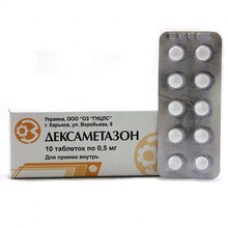Expiration date: 04/2026
International and chemical names: dexamethasone, (9-fluoro-11, 17, 21-trihydroxy-16-methylpregna-1, 4-diene-3, 20-dione),
basic physical and chemical properties: white tablets,
Composition: 1 tablet contains dexamethasone 0, 0005 g (0, 5 mg),
excipients: sugar, potato starch, stearic acid.
Form release. Pills.
Pharmacotherapeutic group. Glucocorticoid. PBX code N02A B02.
Pharmacological properties.
Pharmacodynamics. Dexamethasone, as a drug from the group of glucocorticosteroids, has an anti-inflammatory, anti-allergic effect. Reduces the content of eosinophils, lymphocytes, and neutrophils in the blood. It inhibits the development of connective tissue, reduces the number of mast cells, inhibits the activity of hyaluronidase, and reduces capillary permeability. Practically does not cause water and sodium retention in the body, and has relatively little effect on the exchange of electrolytes. The effectiveness of 0, 5 mg of dexamethasone is approximately 3, 5 mg of prednisone, 15 mg of hydrocortisone, 17, 5 mg of cortisone, that is, the drug is 7 times more active than prednisone and 35 times more active than cortisone.
Pharmacokinetics. Dexamethasone is well absorbed from the gastrointestinal tract, distributed throughout the body. The volume of distribution is the same in patients of all age groups. Dexamethasone is metabolized in the liver. The half-life of dexamethasone is about 3, 5 hours the Effect lasts for up to 72 h. Excreted by the kidneys, a very small amount-with bile in the form of metabolites.
Indications for use. Treatment of rheumatoid and other arthritis, periarthritis, ankylosing spondylitis, various dermatitis, dermatoses, acute and chronic allergic diseases (bronchial asthma, hay fever, urticaria), Addison's disease, nephrotic syndrome, lymphogranulomatosis, blood diseases (acute lymphoblastic and myeloblastic leukemia, infectious mononucleosis), organ and tissue transplantation.
Method of administration and dosage. Dexamethasone is prescribed inside during or after a meal. The usual daily dose for adults is 0, 002-0, 003 g (2-3 mg), and in severe cases - up to 0, 004 - 0, 006 g (4 - 6 mg). After reaching the therapeutic effect, the dose is gradually reduced and switched to maintenance doses-0, 0005-0, 001 g (0, 5 - 1 mg) per day. The daily dose is prescribed in 2 to 3 doses. Children, depending on age, at the discretion and under the control of a pediatrician, are prescribed from 0, 00025 g (0, 25 mg, that is ? tablets) to 0, 002 g (2 mg, i.e. 4 tablets). The daily dose is taken in 3 to 4 doses.
Side effect. Steroid diabetes, violation of the secretion of sex hormones (menstrual cycle disorders, hirsutism, impotence), slowing the growth of children, secondary adrenal cortex insufficiency, Itsenko-Cushing syndrome, erosive and ulcerative lesions of the gastrointestinal tract, hemorrhagic pancreatitis, atonia of the digestive tract, increased appetite, nausea, vomiting, dizziness, headache, mood lability, depression, psychosis, sodium retention, etc. water, arterial hypertension, increased intracranial and intraocular pressure, increased risk of thrombosis, petechiae, striae, skin atrophy, eschymosis, osteoporosis, immunosuppression, increased risk of occurrence or exacerbation of fungal, viral or bacterial infections, inhibition of regenerative and reparative processes, increased sweating, myopathy, glaucoma, cataract.
Contraindications. Hypersensitivity to the drug, ulcerative, severe osteoporosis, diabetes, hypertension, severe myopathy, acute psychosis, acute renal failure, glaucoma, pre-and post-immunization (especially antiviral), viral disease, systemic mycosis, active tuberculosis, infectious lesions of joints and periarticular soft tissues, pregnancy and lactation.
Overdose. It is manifested by an increase in the severity of side effects.
Treatment: withdrawal of the drug, symptomatic therapy. There is no specific antidote.
Features of the application. Dexamethasone treatment is carried out in the presence of clear indications and under strict medical supervision, taking into account possible contraindications and complications. Treatment is stopped gradually, since sudden discontinuation of the drug can cause an exacerbation of the pathological process. At the end of treatment, it is advisable to prescribe several injections of corticotropin (10-20 UNITS per day). It is necessary to constantly monitor the level of blood pressure, blood glucose, blood clotting, diuresis and body weight.
In diabetes, tuberculosis, bacterial and amoebic infections, arterial hypertension, thromboembolism, heart and kidney failure, the drug should be used very carefully and if it is possible to simultaneously conduct adequate treatment of the underlying disease. If there is an indication of psychosis in the anamnesis, therapy is performed only for vital indications.
With hypothyroidism and cirrhosis of the liver, the effect of the drug may increase.
During Dexamethasone therapy, breast-feeding should be discontinued.
Interaction with other medications. Dexamethasone increases the toxicity of cardiac glycosides (due to the resulting hypokalemia, the risk of arrhythmias increases), weakens the hypoglycemic effect of antidiabetic agents and the anticoagulant effect of coumarin derivatives. Rifampicin, phenytoin, barbiturates weaken, and estrogens-containing oral contraceptives enhance the effect of dexamethasone. Simultaneous use of the drug with saluretics leads to increased excretion of potassium, while simultaneous administration with tyroliberin reduces the level of triglycerides in the blood. Non-steroidal anti-inflammatory drugs and ethanol increase the safety of ulceration of the gastrointestinal mucosa, in combination with non-steroidal anti-inflammatory drugs for the treatment of arthritis, it is possible to reduce the dose of glucocorticosteroids due to the summation of the therapeutic effect. Antimalarial agents (chloroquine, hydroxychloroquine, mefloquine) together with dexamethasone can increase the risk of developing myopathy, cardiomyopathy. ACE inhibitors when used simultaneously with dexamethasone can change the composition of peripheral blood. Immunosuppressants increase the risk of developing infections and lymphoma or other lymphoprorliferative disorders associated with the Epstein-Barr virus. Cyclosporine (inhibits metabolism) and ketoconazole (reduces clearance) increase toxicity. In high doses, dexamethasone reduces the effect of somatropin. Antacids reduce the absorption of glucocorticosteroids. The drug increases (with long-term therapy) the content of folic acid. Increases the risk of paracetamol hepatotoxic reactions (induction of liver enzymes and formation of a toxic metabolite of paracetamol).


